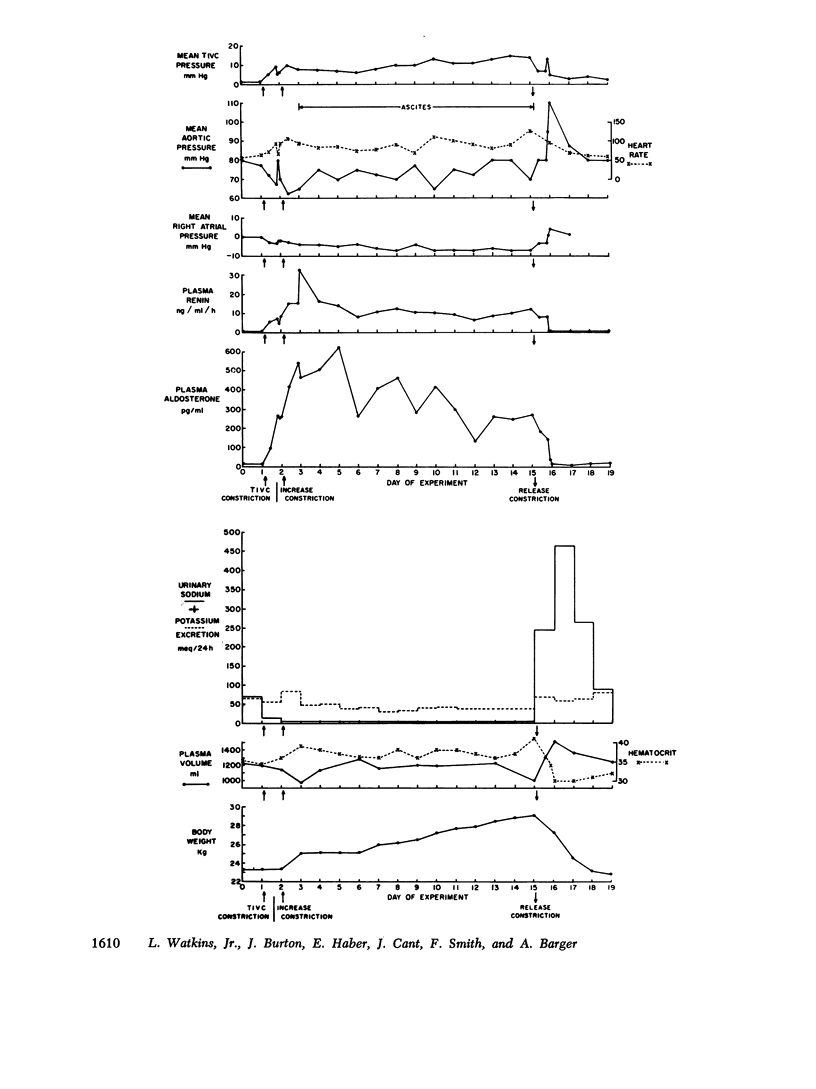Abstract
The role of the renin-angiotensin-aldosterone system in the development of congestive failure has been assessed in the conscious dog by use of the nonapeptide converting enzyme inhibitor. Constriction of the pulmonary artery or thoracic inferior vena cava was maintained for 2 wk while daily measurements were made of plasma renin activity, plasma aldosterone, plasma volume, hematocrit, serum sodium and potassium concentrations, sodium and water balance, body weight, and arterial, caval, and atrial pressures. The initial response to constriction was a reduction in blood pressure, a rise in plasma renin activity, plasma aldosterone, and water intake, and nearly complete sodium retention. In the days after moderate constriction plasma volume and body weight increased (with development of ascites and edema); blood pressure, sodium excretion, plasma renin acvitity, and plasma aldosterone returned to normal. In animals in which blood pressure was not restored, plasma renin activity and plasma aldosterone remained elevated throughout the period of constriction. Single injections of converting enzyme inhibitor reduced blood pressure when plasma renin activity was elevated. Chronic infusion of the inhibitor in dogs with thoracic inferior vena caval constriction prevented the restoration of blood pressure and suppressed the rise in plasma aldosterone; sodium retention and volume expansion were less than in control experiments. Thus the renin-angiotensin-aldosterone system plays an essential role in the maintenance of blood pressure during the genesis of congestive failure. Initially, the restoration of blood pressure is dependent upon circulating angiotensin II; in the later stages, blood pressure is dependent upon the increase in plasma volume.
Full text
PDF











Selected References
These references are in PubMed. This may not be the complete list of references from this article.
- BARGER A. C. The pathogenesis of sodium retention in congestive heart failure. Metabolism. 1956 Jul;5(4):480–489. [PubMed] [Google Scholar]
- Bakhle Y. S. Inhibition of angiotensin I converting enzyme by venom peptides. Br J Pharmacol. 1971 Sep;43(1):252–254. doi: 10.1111/j.1476-5381.1971.tb07176.x. [DOI] [PMC free article] [PubMed] [Google Scholar]
- Belleau L., Mion H., Simard S., Granger P., Bertranou E., Nowaczynski W., Boucher R., Genest J. Studies on the mechanism of experimental congestive heart failure in dogs. Can J Physiol Pharmacol. 1970 Jul;48(7):450–456. doi: 10.1139/y70-069. [DOI] [PubMed] [Google Scholar]
- Brennan L. A., Jr, Malvin R. L., Jochim K. E., Roberts D. E. Influence of right and left atrial receptors on plasma concentrations of ADH and renin. Am J Physiol. 1971 Jul;221(1):273–278. doi: 10.1152/ajplegacy.1971.221.1.273. [DOI] [PubMed] [Google Scholar]
- Brown J. J., Davies D. L., Johnson V. W., Lever A. F., Robertson J. I. Renin relationships in congestive cardiac failure, treated and untreated. Am Heart J. 1970 Sep;80(3):329–342. doi: 10.1016/0002-8703(70)90098-0. [DOI] [PubMed] [Google Scholar]
- DAVIS J. O. Adrenocortical and renal hormonal function in experimental cardiac failure. Circulation. 1962 Jun;25:1002–1014. doi: 10.1161/01.cir.25.6.1002. [DOI] [PubMed] [Google Scholar]
- DAVIS J. O., PECHET M. M., BALL W. C., Jr, GOODKIND M. J. Increased aldosterone secretion in dogs with right-sided congestive heart failure and in dogs with thoracic inferior vena cava constriction. J Clin Invest. 1957 May;36(5):689–694. doi: 10.1172/JCI103470. [DOI] [PMC free article] [PubMed] [Google Scholar]
- Epstein M., Pins D. S., Sancho J., Haber E. Suppression of plasma renin and plasma aldosterone during water immersion in normal man. J Clin Endocrinol Metab. 1975 Sep;41(3):618–625. doi: 10.1210/jcem-41-3-618. [DOI] [PubMed] [Google Scholar]
- FERREIRA S. H. A BRADYKININ-POTENTIATING FACTOR (BPF) PRESENT IN THE VENOM OF BOTHROPS JARARCA. Br J Pharmacol Chemother. 1965 Feb;24:163–169. doi: 10.1111/j.1476-5381.1965.tb02091.x. [DOI] [PMC free article] [PubMed] [Google Scholar]
- Genest J., Granger P., De Champlain J., Boucher R. Endocrine factors in congestive heart failure. Am J Cardiol. 1968 Jul;22(1):35–42. doi: 10.1016/0002-9149(68)90244-0. [DOI] [PubMed] [Google Scholar]
- HERD J. A., BARGER A. C. SIMPLIFIED TECHNIQUE FOR CHRONIC CATHETERIZATION OF BLOOD VESSELS. J Appl Physiol. 1964 Jul;19:791–792. doi: 10.1152/jappl.1964.19.4.791. [DOI] [PubMed] [Google Scholar]
- Haber E., Koerner T., Page L. B., Kliman B., Purnode A. Application of a radioimmunoassay for angiotensin I to the physiologic measurements of plasma renin activity in normal human subjects. J Clin Endocrinol Metab. 1969 Oct;29(10):1349–1355. doi: 10.1210/jcem-29-10-1349. [DOI] [PubMed] [Google Scholar]
- Johnson J. A., Davis J. O. Angiotensin. II. Important role in the maintenance of arterial blood pressure. Science. 1973 Mar 2;179(4076):906–907. doi: 10.1126/science.179.4076.906. [DOI] [PubMed] [Google Scholar]
- Mancia G., Romero J. C., Shepherd J. T. Continuous inhibition of renin release in dogs by vagally innervated receptors in the cardiopulmonary region. Circ Res. 1975 Apr;36(4):529–535. doi: 10.1161/01.res.36.4.529. [DOI] [PubMed] [Google Scholar]
- Miller E. D., Jr, Samuels A. I., Haber E., Barger A. C. Inhibition of angiotensin conversion and prevention of renal hypertension. Am J Physiol. 1975 Feb;228(2):448–453. doi: 10.1152/ajplegacy.1975.228.2.448. [DOI] [PubMed] [Google Scholar]
- Ondetti M. A., Williams N. J., Sabo E. F., Pluscec J., Weaver E. R., Kocy O. Angiotensin-converting enzyme inhibitors from the venom of Bothrops jararaca. Isolation, elucidation of structure, and synthesis. Biochemistry. 1971 Oct 26;10(22):4033–4039. doi: 10.1021/bi00798a004. [DOI] [PubMed] [Google Scholar]
- Poulsen K., Sancho J., Haber E. A simplified radioimmunoassay for plasma aldosterone employing an antibody of unique specificity. Clin Immunol Immunopathol. 1974 Apr;2(3):373–380. doi: 10.1016/0090-1229(74)90055-5. [DOI] [PubMed] [Google Scholar]
- ROSS J. F., BARGER A. C., FINCH S. C., ROSS R. S., PRICE H. L., FREIREICH E. J. The blood volume before and following experimentally produced congestive heart failure in dogs. Trans Assoc Am Physicians. 1953;66:278-89; discussion, 289-93. [PubMed] [Google Scholar]
- SANDERS L. L., MELBY J. C. ALDOSTERONE AND THE EDEMA OF CONGESTIVE HEART FAILURE. Arch Intern Med. 1964 Mar;113:331–341. doi: 10.1001/archinte.1964.00280090017004. [DOI] [PubMed] [Google Scholar]
- Simpson J. B., Routtenberg A. Subfornical organ: site of drinking elicitation by angiotensin II. Science. 1973 Sep 21;181(4105):1172–1175. doi: 10.1126/science.181.4105.1172. [DOI] [PubMed] [Google Scholar]
- Tagawa H., Gutmann F. D., Haber E., Miller E. D., Jr, Samuels A. I., Barger A. C. Reversible renovascular hypertension and renal arterial pressure. Proc Soc Exp Biol Med. 1974 Sep;146(4):975–982. doi: 10.3181/00379727-146-38231. [DOI] [PubMed] [Google Scholar]
- Witty R. T., Davis J. O., Shade R. E., Johnson J. A., Prewitt R. L. Mechanisms regulating renin release in dogs with thoracic caval constriction. Circ Res. 1972 Sep;31(3):339–347. doi: 10.1161/01.res.31.3.339. [DOI] [PubMed] [Google Scholar]


